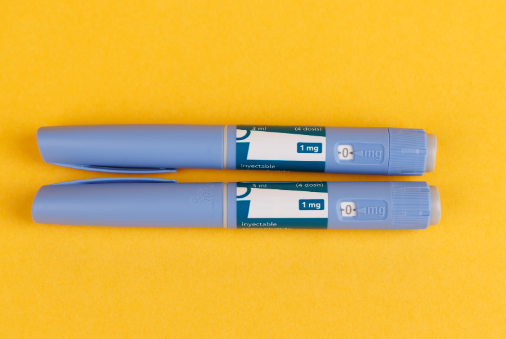Why GLP-1 Medications Are the Future of Weight Loss

In medicine, few breakthroughs have been as transformative as GLP-1 medications. Initially developed for the treatment of type 2 diabetes, these medications are now making waves as highly effective tools for weight loss. Let's explore why GLP-1 medications are being hailed as life-changing solutions from their origins to their current applications.
What Are GLP-1 Medications?
GLP-1, or glucagon-like peptide-1, is a hormone naturally produced in the body. It plays a key role in regulating blood sugar levels and appetite by:
- - Stimulating insulin release in response to meals.
- - Slowing down gastric emptying, which helps control hunger.
- - Suppressing the release of glucagon, a hormone that raises blood sugar.
GLP-1 receptor agonists are medications designed to mimic these effects, offering significant benefits for people with type 2 diabetes and, more recently, those looking to manage obesity.
Popular GLP-1 Medications on the Market

1. Semaglutide (Common Brands: Ozempic, Wegovy)
Semaglutide is one of the most talked-about GLP-1 medications, marketed under the brand names Ozempic and Wegovy. Ozempic is widely prescribed for managing type 2 diabetes, helping to stabilize blood sugar levels while offering the added benefit of weight reduction. Wegovy, on the other hand, is specifically FDA-approved for weight loss in individuals with obesity or overweight conditions. Both medications are administered as weekly injections and have been shown in clinical studies to help patients lose up to 15% of their body weight, making semaglutide a game-changer in the field of metabolic health.
2. Liraglutide (Common Brands: Victoza, Saxenda)
Liraglutide offers a versatile solution with two distinct applications. Victoza is designed for people with type 2 diabetes, effectively controlling blood sugar levels and reducing cardiovascular risks. Saxenda, the same medication at a higher dose, is FDA-approved for weight management in adults and adolescents aged 12 and older. Administered via daily injection, liraglutide has been a trusted option for years, with proven efficacy in promoting sustainable weight loss and improving metabolic markers.
3. Tirzepatide (Common Brand: Mounjaro)
Tirzepatide is a newer dual-action medication that combines GLP-1 and GIP (glucose-dependent insulinotropic polypeptide) receptor agonists. It is FDA-approved for type 2 diabetes and shows impressive results for weight loss in clinical trials. With significant reductions in body weight—sometimes exceeding 20%—and enhanced blood sugar control, tirzepatide represents the next frontier in GLP-1 medications.
When you’re looking for effective weight loss solutions, GLP-1 medications like semaglutide, liraglutide, and tirzepatide offer promising outcomes backed by clinical research.
4. Dulaglutide (Common Brand: Trulicity)
Trulicity is a once-weekly injection that focuses on type 2 diabetes management. It helps lower blood sugar levels and reduce the risk of cardiovascular events in high-risk patients. Although not officially approved for weight loss, dulaglutide users often report modest weight reductions as a secondary benefit. Its convenient weekly dosing and broad availability make it a popular choice for diabetes care.
5. Exenatide (Common Brands: Bydureon, Byetta)
Exenatide is available in two formulations: Bydureon, a once-weekly injection, and Byetta, a twice-daily option. Both versions are primarily used to manage blood sugar levels in type 2 diabetes patients. While not marketed for weight loss, many patients experience reduced appetite and moderate weight reductions as an added advantage. Exenatide remains a cost-effective and reliable GLP-1 option for those prioritizing diabetes control.
Why Are GLP-1 Medications Revolutionary?
1. Effective Weight Loss: Many GLP-1 users report substantial weight loss, often exceeding the results of traditional diet and exercise alone. This is a boon for individuals struggling with obesity-related health issues.
2. Improved Metabolic Health: By regulating blood sugar and reducing appetite, these medications significantly lower the risk of cardiovascular diseases, a common concern for individuals with diabetes and obesity.
3. Convenience: With options for weekly injections, GLP-1 medications offer a practical solution for those who prefer less frequent dosing.
4. Dual Purpose: These medications address both diabetes and weight loss, making them a comprehensive treatment option for patients with overlapping conditions.
Who Can Benefit From GLP-1 Medications?

GLP-1 medications are typically prescribed for:
- - Individuals with type 2 diabetes who need better blood sugar control.
- - People with a BMI of 30 or above (or 27 with weight-related health issues) seeking medical weight loss solutions.
- - Patients who struggle with hunger regulation and portion control.
However, these medications aren’t suitable for everyone. Those with a history of medullary thyroid cancer or certain endocrine conditions should avoid GLP-1 receptor agonists
What are the Potential Side Effects of GLP-1 Meds?
While GLP-1 medications are generally well-tolerated, they can cause side effects such as:
- - Nausea or vomiting
- - Diarrhea or constipation
- - Decreased appetite
- - Rarely, pancreatitis or gallbladder issues
Most side effects are mild and often subside as the body adjusts to the medication.
Regular vs Compounded GLP-1 Medications: Which Should You Choose?
Choosing between regular and compounded GLP-1 medications depends on individual needs, financial situation, and access to healthcare resources. Here are some of the differences to consider.
Aspect
Regular GLP-1 Medications
Compounded GLP-1 Medications
Manufacturing Process
FDA-approved, manufactured by pharmaceutical companies with strict quality controls.
Created by compounding pharmacies, often customized for individual needs, sometimes with added ingredients like vitamin B12.
Regulation
Rigorously tested and monitored by the FDA for safety and effectiveness.
Not FDA-approved, regulated by state boards, but lacks extensive testing.
Cost
Expensive, often with high out-of-pocket costs without insurance coverage.
Usage and Customization
Standardized dosage and delivery, with clear FDA-approved guidelines. Prescribed for diabetes management or weight loss.
Availability
Widely available at pharmacies but may require insurance approval. Limited supply issues may occur due to demand.
Available through select compounding pharmacies, no major supply chain issues but requires finding a reputable pharmacy.
Risk and Benefits
Proven track record of safety and effectiveness; however, comes with potential side effects (e.g., nausea, vomiting) and high costs.
Cost-saving and customizable; however, risks include variable quality, potential contamination, and lack of consistency in dosing.
While regular GLP-1 medications are the gold standard in terms of safety and efficacy, compounded versions offer affordability and customization but come with potential risks and variability. Always consult with a healthcare provider before deciding which option is best for you.
Oral vs. Injectable GLP-1 Medications: Finding the Right Fit for Your Needs
GLP-1 medications have multiple administration methods to suit different lifestyles. While oral options provide convenience, injectable forms are known for their enhanced efficacy. Here's a clear comparison to guide your choice.
Aspect
Oral GLP-1 Medications
Injectable GLP-1 Medications
Examples
Rybelsus (oral semaglutide)
Ozempic, Wegovy, Trulicity, Saxenda
Administration
Taken as a pill, usually once daily on an empty stomach
Administered via subcutaneous injection (daily or weekly)
Absorption
Absorption can be affected by food and stomach pH
Effectiveness
Requires higher doses to be as effective as injectables
Convenience
Convenient pill form, but requires timing (empty stomach)
Requires injections, but newer options are weekly
Side Effects
Similar to injectables, but may be more pronounced due to higher doses
Nausea, vomiting, and GI discomfort, though generally more predictable
Who It's For
Ideal for those who dislike injections or prefer a daily pill
Best for those needing more robust blood sugar control or weight loss
Dosing Frequency
Daily
Daily or weekly (depending on the medication)
Understanding the differences between oral and injectable GLP-1 medications can help you make informed decisions tailored to your preferences and medical requirements.
For a more detailed breakdown comparing the two medication types, read our full article to help make the best decision for you.
Our Top Picks For GLP-1

© 2017-2022 Media122 (Top5.com and TopFive.com) All Rights Reserved
Other marks contained on this website are the property of their respective owners. Top5 is an independent comparison and review website may contain references to products from one or more of Top5 advertisers. Top5 is a free to use website is supported through compensation when you click on links to products. Please read ourPrivacy PolicyandTerms of Use
DISCLAIMER
This website is not intended to provide medical advice or to take the place of medical advice and treatment from your personal physician. Visitors are advised to consult their own doctors or other qualified health professional regarding the treatment of medical conditions. The author shall not be held liable or responsible for any misunderstanding or misuse of the information contained on this site or for any loss, damage, or injury caused, or allegedly caused, directly or indirectly by any treatment, action, or application of any food or food source discussed on this website. The U.S. Food and Drug Administration have no evaluated the statements on this website. This information is not intended to diagnose, treat, cure, or prevent disease.

